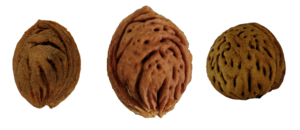Prunus kansuensis facts for kids
Quick facts for kids Prunus kansuensis |
|
|---|---|
| Scientific classification | |
| Genus: |
Prunus
|
| Species: |
kansuensis
|
| Synonyms | |
|
|
Prunus kansuensis (also known as the Gansu peach or Chinese bush peach) is a type of peach tree or shrub. It grows naturally in several provinces of China, like Gansu, Guizhou, and Sichuan. This plant can grow from about 10 to 23 feet tall. It likes to live in places that are high up, between 3,300 and 7,500 feet above sea level.
Scientists have studied P. kansuensis closely. They found it is actually the same species as the regular peach, Prunus persica, which is the one we usually eat. P. kansuensis is very special because it can resist many diseases, dry weather, and even very cold temperatures. This makes it useful for growing stronger peach trees. For example, it is not affected by a disease called peach mosaic virus. It can also fight off tiny worms called root-knot nematodes. Plus, it can survive winter temperatures as low as -35 degrees Celsius (about -31 degrees Fahrenheit)!
Contents
What Does the Chinese Bush Peach Look Like?
It can be tricky to tell Prunus kansuensis apart from its close relatives. These include P. mira (the Tibetan peach), P. davidiana (the Chinese wild peach), and P. persica (the domestic peach). It's especially hard if you only look at the leaves and branches.
How Is It Different from Other Peaches?
Many P. kansuensis plants grow as shrubs, which are smaller and bushier. Most other peach species grow as trees.
The seed covering, called the endocarp, is smooth in P. kansuensis and P. mira. But in P. davidiana and P. persica, the endocarp has a bumpy, pitted look, like the pit of a regular peach.
You can tell P. kansuensis from P. mira by looking at their sepals. Sepals are the small, leaf-like parts that protect the flower bud. P. kansuensis sepals usually have tiny hairs on the outside. P. mira sepals are smooth.
The fruit flesh, called the mesocarp, of P. davidiana dries out. The fruits of the other peach species stay moist. P. davidiana also has other unique features and is genetically different from the other peaches.
Looking at Buds and Leaves
The winter buds of P. kansuensis are oval-shaped and smooth. P. persica winter buds are cone-shaped and have tiny hairs.
The leaf stems, called petioles, of P. kansuensis are short, about 0.5 to 1 centimeter long. P. persica petioles are longer, about 1 to 2 centimeters.
There are also small differences in the leaves. P. kansuensis leaves are usually a bit shorter. They also have fewer jagged edges, called serrations, along their sides compared to P. persica.
Flower Differences
The flowers also have subtle differences. In P. kansuensis flowers, the styles (the part of the flower that receives pollen) are longer than the stamens (the parts that produce pollen). In P. persica flowers, the styles are shorter than or the same length as the stamens.

Why Is the Chinese Bush Peach Important?
In China, P. kansuensis is used as a rootstock for other peach and almond trees. A rootstock is the lower part of a plant onto which another plant is grafted. This helps the new tree grow stronger and healthier.
Sometimes, people also grow P. kansuensis as an ornamental plant. This means they grow it just for its beauty. It has many lovely shell-pink flowers that bloom early in spring. When it is cared for, it often grows into a tree shape.
P. kansuensis is also a ruderal species. This means it's a plant that grows well in disturbed areas, like old farmland. It is used in projects to turn farmland back into forests. This plant can help farmers earn some money during this change.
The fruit of P. kansuensis has white flesh and is quite small. It doesn't have much flavor, so it's not usually sold in stores. However, some local people do grow and eat them. The fruit is also a food source for endangered golden snub-nosed monkeys (Rhinopithecus roxellana).

